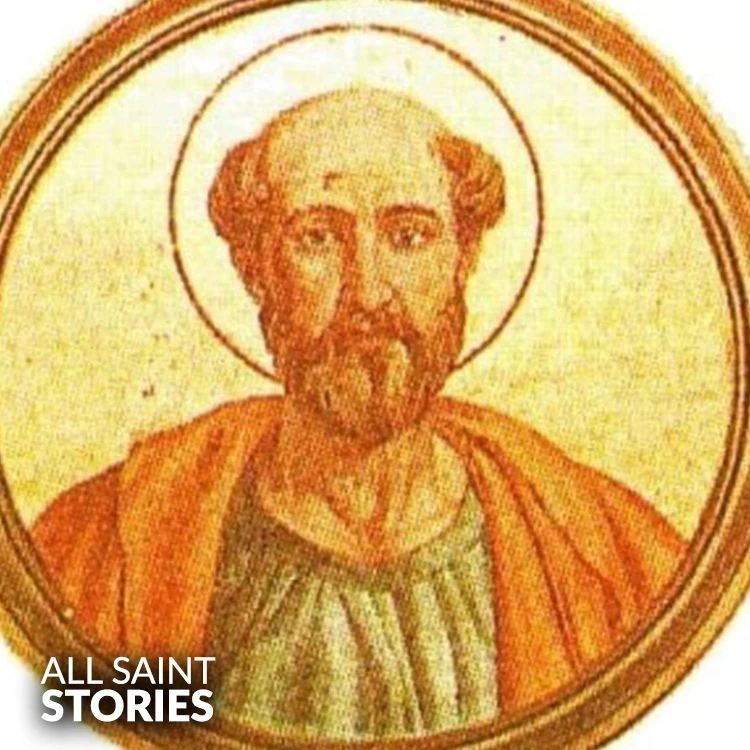O holy Pope and martyr St. Telesphorus, shepherd of the early Church, intercede for us that we may remain steadfast in faith and loyal to Christ in all our trials. Through your guidance, may we honor the traditions of the Church and grow in love for the Eucharist and prayer. Amen.
ST. TELESPHORE (POPE)
ST. TELESPHORE (POPE)

St. Telesphorus was the 8th Pope of the Catholic Church, serving from around 125 to 136 AD. Believed to be of Greek origin, he is remembered for his holiness, contributions to early liturgy, and martyrdom. His feast day is January 5.
St. Telesphorus was an early Bishop of Rome, believed to have served as Pope from around the year 125 AD until his death around 136 AD. He is traditionally considered the eighth pope, succeeding Pope Sixtus I and preceding Pope Hyginus. His papacy took place during the reigns of the Roman Emperors Hadrian and Antoninus Pius. Despite limited documentation from the period, his name and sanctity are preserved in both ecclesiastical records and the Roman Canon of the Mass.
Telesphorus is believed to have been of Greek origin, and some sources suggest he may have come from Calabria in Southern Italy. His background as a hermit before ascending to the papacy is occasionally noted in traditions, although definitive historical evidence is lacking. The period in which he led the early Church was marked by relative peace but continued tension with Roman authorities, and Christians were still considered a minority cult within the Roman Empire.
The historical record of Pope Telesphorus includes references from Church Fathers, particularly St. Irenaeus of Lyons, who wrote in the second century and named Telesphorus as a martyr for the faith. This is significant, as very few of the early popes are explicitly mentioned in such early writings as having been martyred. His recognition as a martyr is therefore rooted in early Church tradition and respected even in modern scholarship, despite the absence of detailed hagiographical accounts or a recorded acta.
Among the liturgical traditions attributed to Telesphorus is the institution of the Midnight Mass on Christmas Eve, an important and beloved observance in the Christian calendar. He is also traditionally credited with introducing the practice of celebrating the season of Lent as a time of fasting and preparation leading up to Easter, though both attributions are somewhat disputed by scholars due to the lack of contemporary documentation. Nevertheless, these traditions highlight the reverence with which he was held by later generations and underscore his influence on the evolving liturgical life of the Church.
Telesphorus is included in the Roman Canon, also known as Eucharistic Prayer I, where he is named among the early popes and martyrs. This inclusion is a sign of his recognized sanctity and importance in the foundational years of the Church. The Canon lists him alongside other early saints and serves as a liturgical witness to his veneration by the universal Church.
Like many early popes, the exact date and location of his birth are unknown, and records regarding his burial place are also unclear. He likely died in Rome and was buried there, possibly in one of the Christian catacombs, although no definitive archaeological evidence has been confirmed. As with other early saints, Telesphorus was canonized by popular acclaim and local veneration well before the formal canonization process was established in the Catholic Church.
His feast day is celebrated annually on January 5 and remains on the liturgical calendar of both the Roman Catholic and Eastern Catholic Churches. His example of leadership, devotion, and possible martyrdom serves as a source of inspiration for the faithful, particularly in times of trial and uncertainty.
St. Telesphorus’s papacy and memory have been preserved through the writings of early Christian historians, liturgical traditions, and continued commemoration in prayer. Though he lived in a time when Christianity was still emerging from obscurity, his steadfast service and witness contributed significantly to the structure and sanctity of the early Church.
Video Not Found
No images uploaded for this saint yet.
The information on this website is compiled from various trusted sources. While we aim for accuracy, some details may be incomplete or contain discrepancies.
If you notice any errors or have additional information about this saint, please use the form on the left to share your suggestions. Your input helps us improve and maintain reliable content for everyone.
All submissions are reviewed carefully, and your personal details will remain confidential. Thank you for contributing to the accuracy and value of this resource.
Credits & Acknowledgments
- Anudina Visudhar (Malayalam) – Life of Saints for Everyday
by Msgr. Thomas Moothedan, M.A., D.D. - Saint Companions for Each Day
by A. J. M. Mausolfe & J. K. Mausolfe - US Catholic (Faith in Real Life) – Informational articles
- Wikipedia – General reference content and images
- Anastpaul.com – Saint images and reflections
- Pravachaka Sabdam (Malayalam) – Saint-related content and insights
We sincerely thank these authors and platforms for their valuable contributions. If we have unintentionally missed any attribution, please notify us, and we will make the correction promptly.
If you have any suggestion about ST. TELESPHORE (POPE)
Your suggestion will help improve the information about this saint. Your details will not be disclosed anywhere.
© 2025 Copyright @ www.allsaintstories.com

 English
English
 Italian
Italian
 French
French
 Spanish
Spanish
 Malayalam
Malayalam
 Russian
Russian
 Korean
Korean
 Sinhala
Sinhala
 Japanese
Japanese
 Arabic
Arabic
 Portuguese
Portuguese
 Bantu
Bantu
 Greek
Greek
 German
German
 Dutch
Dutch
 Filipino
Filipino